Amaurosis Study guides, Class notes & Summaries
Looking for the best study guides, study notes and summaries about Amaurosis? On this page you'll find 222 study documents about Amaurosis.
Page 4 out of 222 results
Sort by
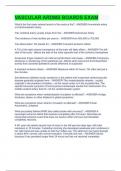
-
VASCULAR ARDMS BOARDS EXAM
- Exam (elaborations) • 47 pages • 2023
- Available in package deal
-
- $13.99
- + learn more
What's the first major arterial branch of the aorta is the? - ANSWER-Innominate artery or brachiocephalic artery The vertebral artery usually arises from the: - ANSWER-Subclavian Artery The incidence of new strokes per year is: - ANSWER-from 500,000 to 700,000 The abbreviation TIA stands for: - ANSWER-Transient Ischemic Attack A TIA of the right anterior hemisphere of the brain will likely affect: - ANSWER-The left side of the body - affects the side of the body opposite that of the...
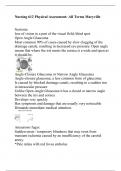
-
Nursing 612 Physical Assessment: All Terms Maryville
- Exam (elaborations) • 35 pages • 2023
-
Available in package deal
-
- $15.49
- + learn more
Scotoma loss of vision in a part of the visual field; blind spot. Open Angle Glaucoma Most common 90% of cases-caused by slow clogging of the drainage canals, resulting in increased eye pressure. Open angle means that where the iris meets the cornea is a wide and open as it should be. Angle-Closure Glaucoma or Narrow Angle Glaucoma Angle-closure glaucoma, a less common form of glaucoma: Is caused by blocked drainage canals, resulting in a sudden rise in intraocular pressure Unlike Open...
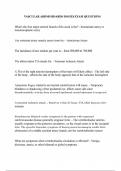
-
VASCULAR ARDMS BOARDS DAVIES EXAM QUESTIONS
- Exam (elaborations) • 72 pages • 2024
-
Available in package deal
-
- $12.00
- + learn more
What's the first major arterial branch of the aorta is the? - Innominate artery or brachiocephalic artery The vertebral artery usually arises from the: - Subclavian Artery The incidence of new strokes per year is: - from 500,000 to 700,000 The abbreviation TIA stands for: - Transient Ischemic Attack A TIA of the right anterior hemisphere of the brain will likely affect: - The left side of the body - affects the side of the body opposite that of the ischemic hemisphere Amaurosis Fugax relat...

-
surgery EOR questions with 100% correct answers
- Exam (elaborations) • 22 pages • 2024
- Available in package deal
-
- $12.49
- + learn more
surgery EOR questions with 100% correct answers peripheral artery disease intervention - Answer- first line = exercise/walking program and lifestyle changes + aspirin second = pentoxifylline 3rd = percutaneous angioplasty/stenting if it is critical you need to bypass it how to prevent post op a-fib - Answer- a beta blocker!!! patient has mesenteric ischemia, history of pain after eating, poorly localized or diffuse pain out of proportion to physical exam with weight loss and possibly bl...
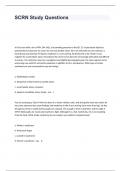
-
SCRN Study Questions Questions and Answers 100% Correct
- Exam (elaborations) • 22 pages • 2024
-
- $12.39
- + learn more
A 67yo man with a hx of HTN, DM, HLD, and smoking presents to the ED. CC of persistent dizziness q1week that has become so severe he now has double vision, N/V. His wife tells you she noticed a L facial droop and slurring. Pt reports weakness in L arm and leg. He denies HA or SZ. Head CT was negative for acute bleed. Upon returning to the room he has become increasingly obtunded and difficult to arouse. You notice he now has a nystagmus and slightly dysconjugate gaze. His exam appears to be wors...
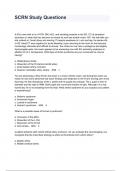
-
SCRN Study Questions And Answers All Verified
- Exam (elaborations) • 14 pages • 2024
-
- $11.49
- + learn more
SCRN Study Questions And Answers All Verified A 67yo man with a hx of HTN, DM, HLD, and smoking presents to the ED. CC of persistent dizziness q1 week that has become so severe he now has double vision, N/V. His wife tells you she noticed a L facial droop and slurring. Pt reports weakness in L arm and leg. He denies HA or SZ. Head CT was negative for acute bleeding. Upon returning to the room he has become increasingly obtunded and difficult to arouse. You notice he now has a nystagmus and sli...
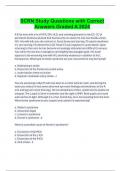
-
SCRN Study Questions with Correct Answers Graded A 2024
- Exam (elaborations) • 17 pages • 2024
- Available in package deal
-
- $13.49
- + learn more
A 67yo man with a hx of HTN, DM, HLD, and smoking presents to the ED. CC of persistent dizziness q1week that has become so severe he now has double vision, N/V. His wife tells you she noticed a L facial droop and slurring. Pt reports weakness in L arm and leg. He denies HA or SZ. Head CT was negative for acute bleed. Upon returning to the room he has become increasingly obtunded and difficult to arouse. You notice he now has a nystagmus and slightly dysconjugate gaze. His exam appears to be wors...
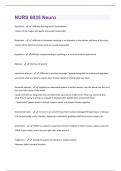
-
NURS 6035 Neuro Questions and Answers
- Exam (elaborations) • 14 pages • 2024
- Available in package deal
-
- $7.19
- + learn more
Dysarthria - -difficulty forming words (articulation) -lesions of the tongue and palate are usually responsible Dysphonia - -difficulty in phonation resulting in an alteration in the volume and tone of the voice -lesions of the palate and vocal cords are usually responsible dysphasia - difficulty comprehending or speaking as a result of cerebral dysfunction Aphasia - total loss of speech expressive aphasia - -Difficulty to produce language ( despite being able to understand language) -you...
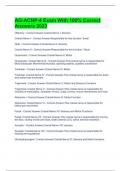
-
AG-ACNP-4 Exam With 100% Correct Answers 2023
- Exam (elaborations) • 34 pages • 2023
-
Available in package deal
-
- $19.49
- + learn more
AG-ACNP-4 Exam With 100% Correct Answers 2023 Olfactory Crainal Nerve I, Sensory Cranial Nerve I Responsible for this function: Smell Optic Cranial Nerve II, Sensory Cranial Nerve II Responsible for this function: Vision Oculomotor Cranial Nerve III: Motor Oculomotor, Cranial Nerve III This cranial nerve is responsible for Most Extaocular Movements/muscles, opeining eyelids, pupillary constriction Trochlear Cranial Nerve IV: Motor Trochlea...
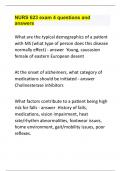
-
NURS 623 exam 4 questions and answers 2024
- Exam (elaborations) • 19 pages • 2024
- Available in package deal
-
- $14.49
- + learn more
What are the typical demographics of a patient with MS (what type of person does this disease normally effect) Young, caucasion female of eastern European desent At the onset of alzheimers, what category of medications should be initiated Cholinesterase inhibitors Previous Play Next Rewind 10 seconds Move forward 10 seconds Unmute 0:08 / 0:15 Full screen Brainpower Read More What factors contribute to a patient being high risk for falls History of falls, medication...

Did you know that on average a seller on Stuvia earns $82 per month selling study resources? Hmm, hint, hint. Discover all about earning on Stuvia


